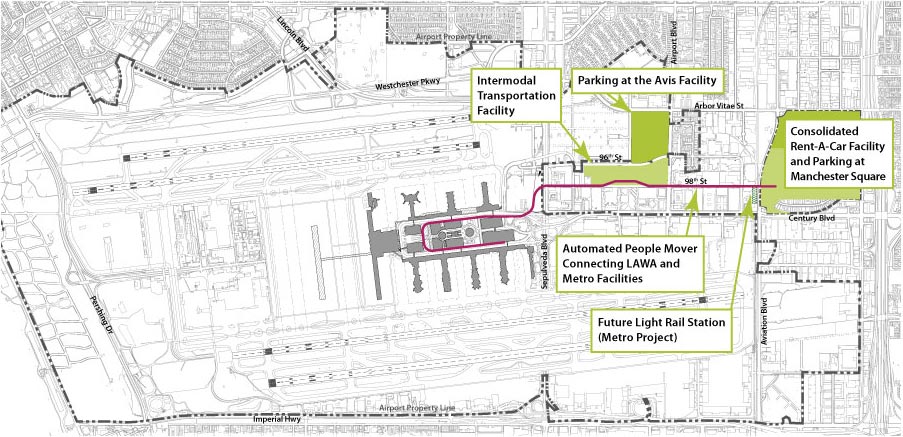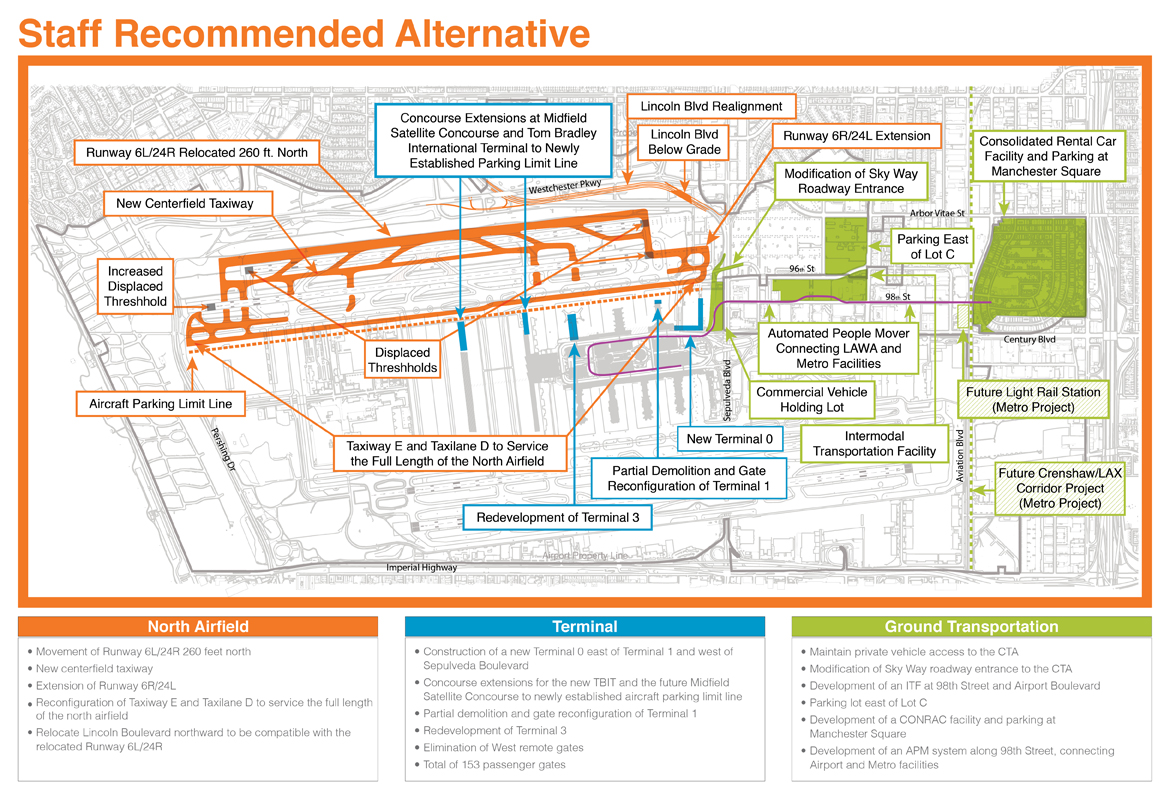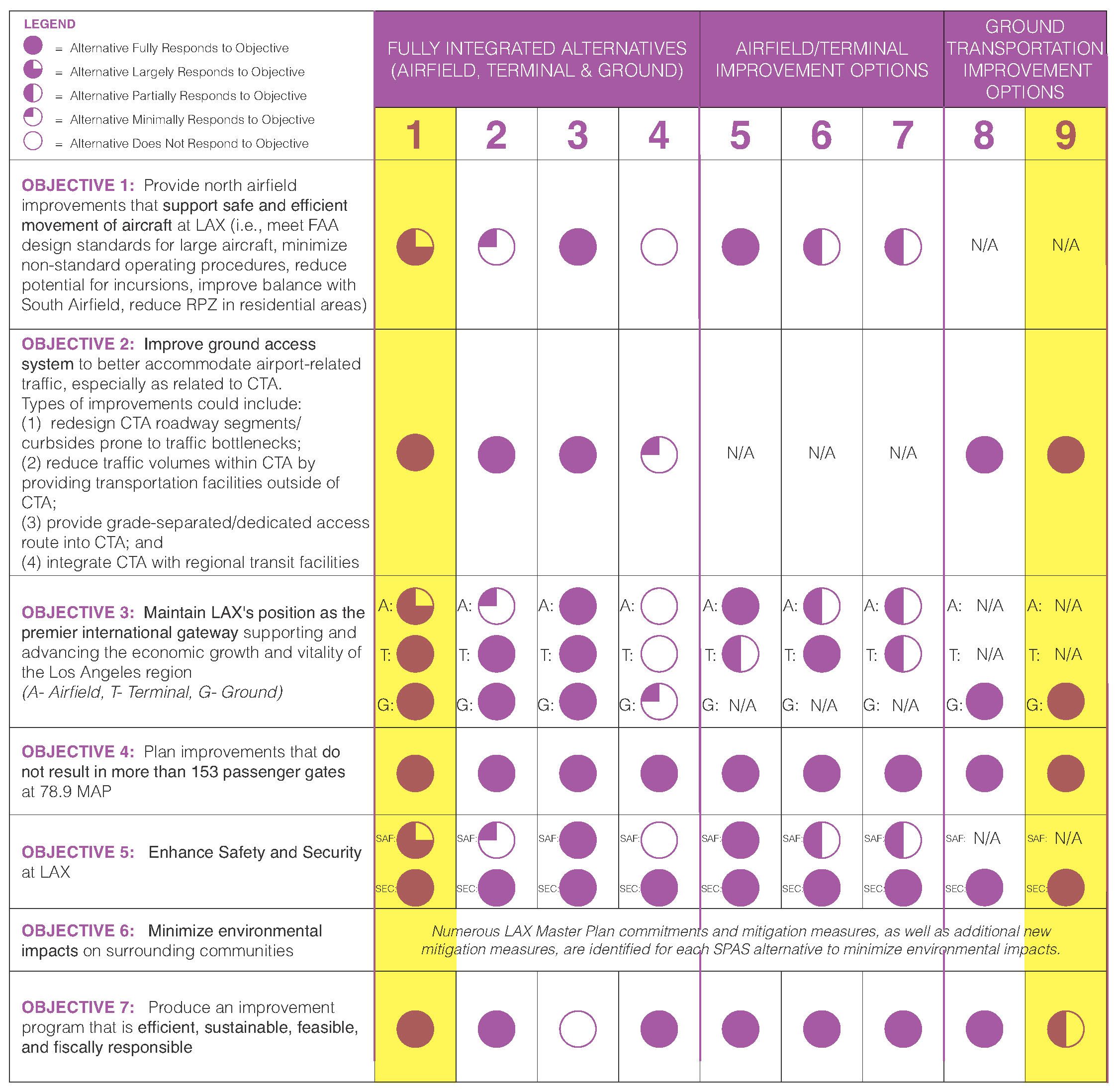LAX Solutions
Click here for Alternative Summary Maps 1-9
Staff Recommended Alternative
The Preliminary SPAS Report and the SPAS Draft EIR identified and evaluated nine potential alternatives to certain components of the previously-approved LAX Master Plan, referred to as Yellow Light Projects, including various configurations for the north airfield, terminal improvements, and improvements to LAX’s ground transportation system. After an extensive review of public comments received during the 75-day public-comment period; staff analysis of the environmental impacts of each alternative; and review of the SPAS Project Objectives, LAWA staff has recommended a combination of the airfield and terminal elements of SPAS Alternative 1 with the ground transportation elements of Alternative 9 as the Recommended Alternative to be considered for adoption by the Board of Airport Commissioners. All components of the Staff Recommended Alternative were described and analyzed in the SPAS Draft EIR.
Key Features of Staff Recommended Alternative
Airfield/Terminal Features:
Achieves construction of a centerline taxiway with a movement of arrivals Runway 6L/24R 260 feet north
Extends Runway 6R/24L eastward
Supports standard operations on the North Airfield, except for Group 6 aircraft when visibility is less than ½ mile
Provides pilot line-of-sight to end of departures runway for all except Group 6 operations
Addresses Runway Safety Area and Taxiway/Taxilane deficiencies
Allows development/redevelopment/extension of Terminal 0, Terminal 3, Tom Bradley International Terminal (Terminal B) and the future Midfield Satellite Concourse
Proposes a maximum of 153 passenger gates
Ground Transportation Features:
Significant new facilities to be developed based on airport ground transportation and passenger conveyance needs, including (but not limited to):
Intermodal Transportation Facility (ITF) in the vicinity of Lot C
Consolidated Rent-A-Car Facility (CONRAC) and long-term parking in Manchester Square o Automated People Mover system (APM) to serve as conveyance between airport and Metro facilities
Redesign of Sky Way
Evaluation of Relationship Between Project Objectives and Staff Recommended Alternative
LAWA staff utilized the “Preliminary Evaluation of the Relationship Between the Project Objectives and the SPAS Alternatives” (see SPAS DEIR Board 3.5) as it considered recommending a particular alternative to decision-makers. The results from the Preliminary Evaluation enabled staff to recommend the Alternative for the following reasons:
The Staff Recommended Alternative provides for standardization of nearly all airfield operations, substantially improves pilot situational awareness, addresses all airfield hazards, and includes airfield efficiency features
The Staff Recommended Alternative provides four of the four types of improvements associated with the ground transportation planning objective: reducing bottlenecks and congestion in the CTA; reducing the volume of vehicles in the CTA by providing alternative locations for pick-up and drop-off; providing grade separated connection between the CTA and other airport transit facilities; and integrating with nearby transit facilities
The Staff Recommended Alternative provides opportunities to modernize terminals and concourses for international passengers
Like other Alternatives, the Staff Recommended Alternative would not result in more than 153 passenger gates at 78.9 Million Annual Passengers (MAP)
The Staff Recommended Alternative would meet existing and anticipated federal security requirements
The DEIR identifies mitigation measures for the Staff Recommended Alternative to mitigate environmental impacts on surrounding communities
Implementation of the Staff Recommended Alternative would provide low to moderate impact on LAWA finances
The chart below illustrates how the Staff Recommended Alternative’s components, the combination of Alternative 1 and Alternative 9, measure against the Project Objectives.
Light Rail Opportunities for Airport Metro Connector
Los Angeles County Metropolitan Transportation Authority (Metro) is in the process of constructing the Crenshaw/LAX Corridor Light Rail Line along Aviation Boulevard, with a station on Century Boulevard and Aviation Boulevard.
In a parallel effort, LAWA is collaborating with Metro to identify convenient connections to LAX. As part of the Airport Metro Connector project, LAWA is working with Metro in examining potential methods to connect Crenshaw/LAX Corridor and Green Line passengers “to the airport”.
The staff recommended SPAS Alternative preserves two additional opportunities should Metro desire to connect Metrorail light rail directly “to the airport”.
The above graphic is only for illustrative purposes and depicts potential locations for light rail/airport circulator connections.
ALTERNATIVES SUMMARY MAPS 1-9
Below you will find the 9 proposed alternatives for the LAX SPAS Project. Each alternative addresses some or all of the following issues for improvement: North Airfield, Terminal and Ground Transportation. To view how each alternative addresses these issues, click on the alternative below. Once you have chosen which alternative to view, click each issue to see what changes are associated with that alternative.
Graphics below are for illustrative purposes and only depict certain features of the Alternatives. For full depiction of the Alternatives, please see Chapter 2 of the Draft EIR.
North Airfield Current Issues
- LAX does not meet federal standards for the largest aircraft now in service (Group 5 and 6 aircraft).
- Current North Airfield configuration requires the use of non-standard operating procedures, which are not optimal for safety and increase aircraft delay.
- Outdated airfield design creates a situation where aircraft are at an increase risk of hazards, including incursions and conflicts with other aircraft and vehicles.
- North Airfield runways are too short for most larger aircraft used for long-haul flights, requiring extra taxiing to the South Airfield.
- Existing North Airfield Runway Protection Zone (RPZ) overlays residential areas.
- Insufficient areas at the ends of the North Airfield runways for holding arriving flights and sequencing departures.
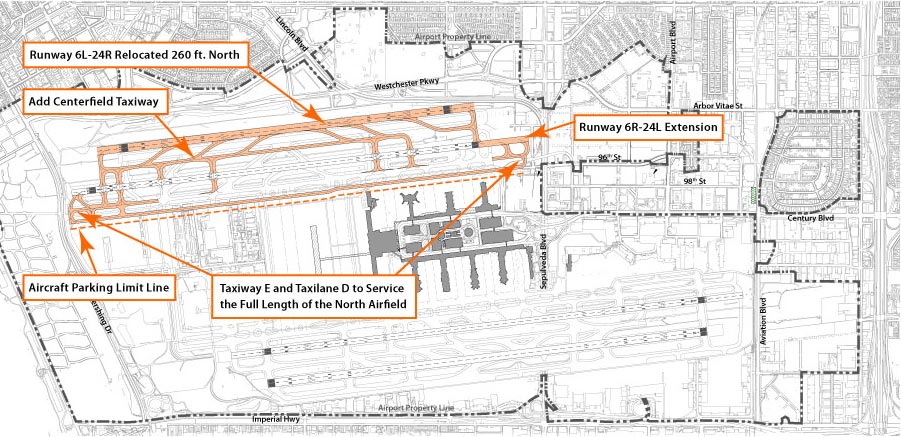
Terminals Current Issues
- Larger aicraft wingspans require greater distances between aircraft gates than available today.
- Some North Airfield improvement options, including the LAX Master Plan move of Runway 6R-24L, would move taxiways too close to Terminals 1, 2, and 3.
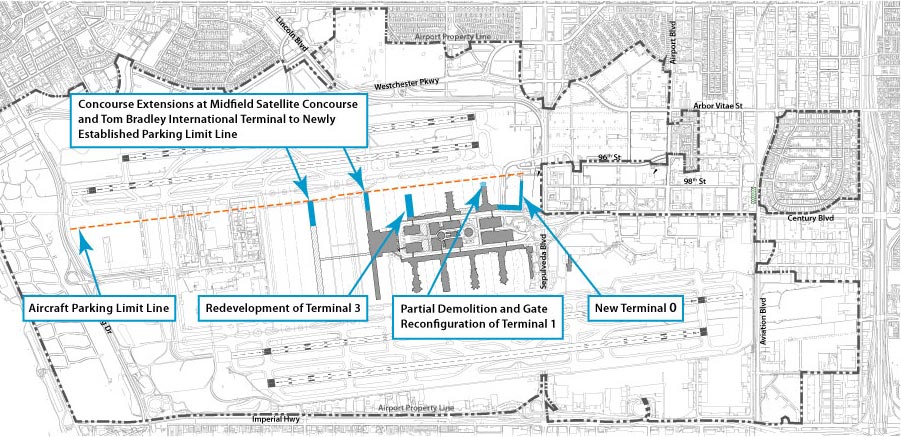
Ground Transportaion Current Issues
- Central Terminal Area (CTA) roadway system design currently creates queuing, weaving, and conflicts at various locations that impede traffic flow.
- During peak travel times, inbound airport traffic currently extends out of the Central Terminal Area (CTA) roadways onto public streets and may worsen as airport activity returns and grows.
- Curbside demand is unevenly distributed, especially during peak periods, creating concentrations of passengers that are not accommodated by the existing curbside system.
- As cumulative regional traffic increases, there will be less time certainty for airport users without easy access to the airport from the regional transit system.
- The roadway system is not designed to efficiently accommodate security screening of vehicles entering the CTA.
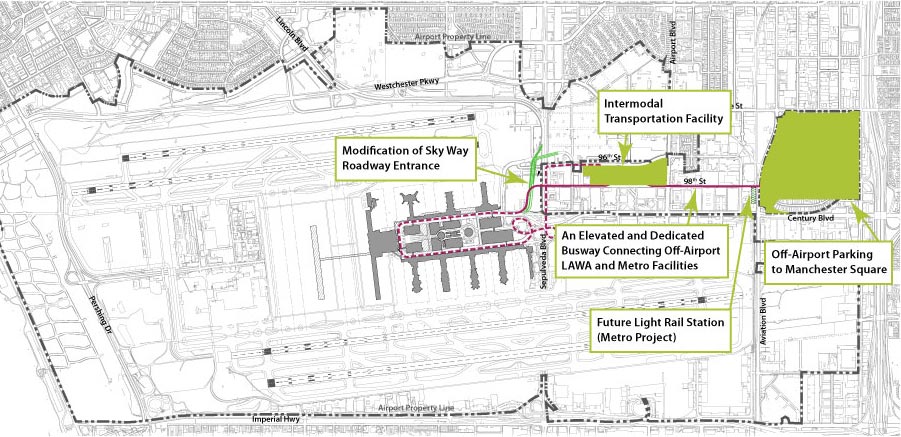
North Airfield Current Issues
- LAX does not meet federal standards for the largest aircraft now in service (Group 5 and 6 aircraft).
- Current North Airfield configuration requires the use of non-standard operating procedures, which are not optimal for safety and increase aircraft delay.
- Outdated airfield design creates a situation where aircraft are at an increase risk of hazards, including incursions and conflicts with other aircraft and vehicles.
- North Airfield runways are too short for most larger aircraft used for long-haul flights, requiring extra taxiing to the South Airfield.
- Existing North Airfield Runway Protection Zone (RPZ) overlays residential areas.
- Insufficient areas at the ends of the North Airfield runways for holding arriving flights and sequencing departures.
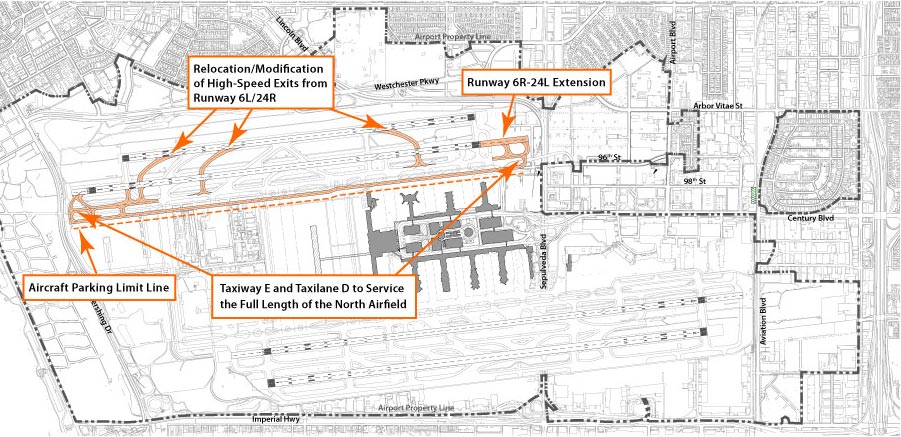
Terminals Current Issues
- Larger aicraft wingspans require greater distances between aircraft gates than available today.
- Some North Airfield improvement options, including the LAX Master Plan move of Runway 6R-24L, would move taxiways too close to Terminals 1, 2, and 3.
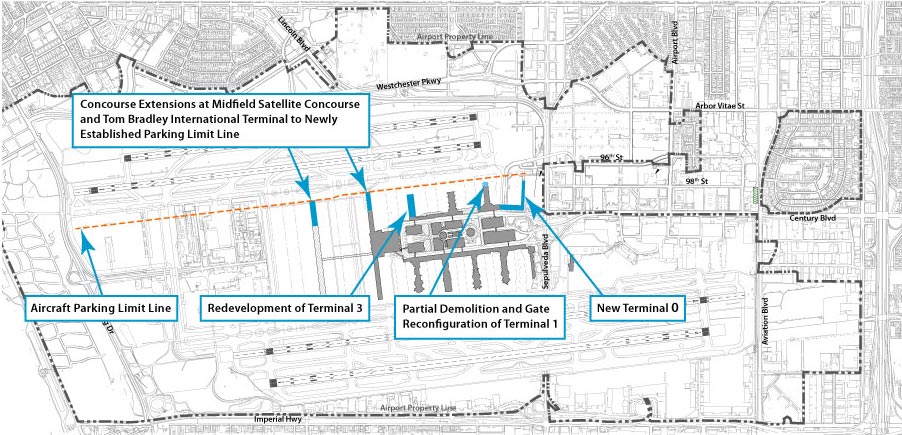
Ground Transportaion Current Issues
- Central Terminal Area (CTA) roadway system design currently creates queuing, weaving, and conflicts at various locations that impede traffic flow.
- During peak travel times, inbound airport traffic currently extends out of the Central Terminal Area (CTA) roadways onto public streets and may worsen as airport activity returns and grows.
- Curbside demand is unevenly distributed, especially during peak periods, creating concentrations of passengers that are not accommodated by the existing curbside system.
- As cumulative regional traffic increases, there will be less time certainty for airport users without easy access to the airport from the regional transit system.
- The roadway system is not designed to efficiently accommodate security screening of vehicles entering the CTA.

North Airfield Current Issues
- LAX does not meet federal standards for the largest aircraft now in service (Group 5 and 6 aircraft).
- Current North Airfield configuration requires the use of non-standard operating procedures, which are not optimal for safety and increase aircraft delay.
- Outdated airfield design creates a situation where aircraft are at an increase risk of hazards, including incursions and conflicts with other aircraft and vehicles.
- North Airfield runways are too short for most larger aircraft used for long-haul flights, requiring extra taxiing to the South Airfield.
- Existing North Airfield Runway Protection Zone (RPZ) overlays residential areas.
- Insufficient areas at the ends of the North Airfield runways for holding arriving flights and sequencing departures.

Terminals Current Issues
- Larger aicraft wingspans require greater distances between aircraft gates than available today.
- Some North Airfield improvement options, including the LAX Master Plan move of Runway 6R-24L, would move taxiways too close to Terminals 1, 2, and 3.
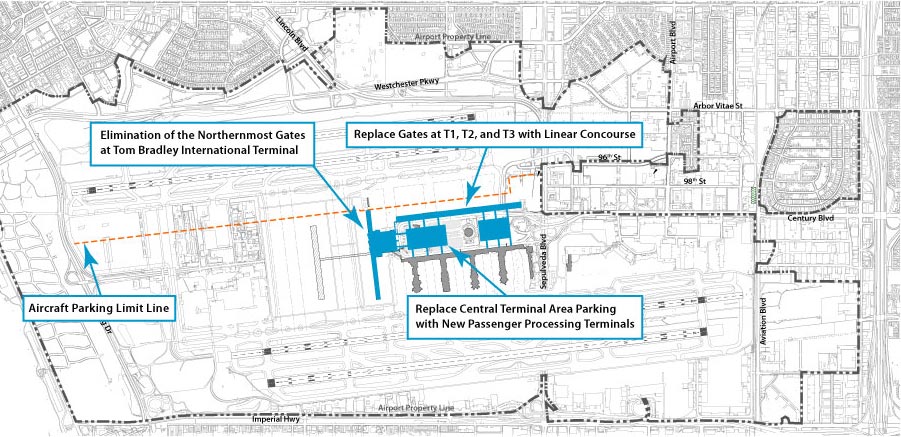
Ground Transportaion Current Issues
- Central Terminal Area (CTA) roadway system design currently creates queuing, weaving, and conflicts at various locations that impede traffic flow.
- During peak travel times, inbound airport traffic currently extends out of the Central Terminal Area (CTA) roadways onto public streets and may worsen as airport activity returns and grows.
- Curbside demand is unevenly distributed, especially during peak periods, creating concentrations of passengers that are not accommodated by the existing curbside system.
- As cumulative regional traffic increases, there will be less time certainty for airport users without easy access to the airport from the regional transit system.
- The roadway system is not designed to efficiently accommodate security screening of vehicles entering the CTA.
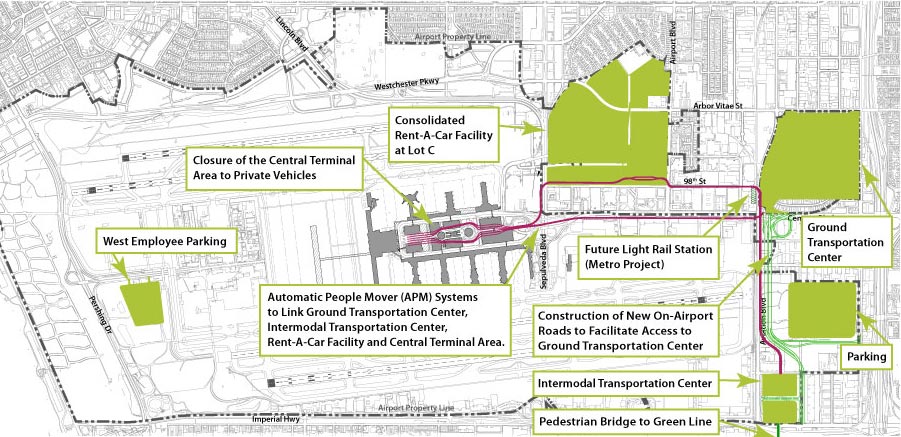
North Airfield Current Issues
- LAX does not meet federal standards for the largest aircraft now in service (Group 5 and 6 aircraft).
- Current North Airfield configuration requires the use of non-standard operating procedures, which are not optimal for safety and increase aircraft delay.
- Outdated airfield design creates a situation where aircraft are at an increase risk of hazards, including incursions and conflicts with other aircraft and vehicles.
- North Airfield runways are too short for most larger aircraft used for long-haul flights, requiring extra taxiing to the South Airfield.
- Existing North Airfield Runway Protection Zone (RPZ) overlays residential areas.
- Insufficient areas at the ends of the North Airfield runways for holding arriving flights and sequencing departures.
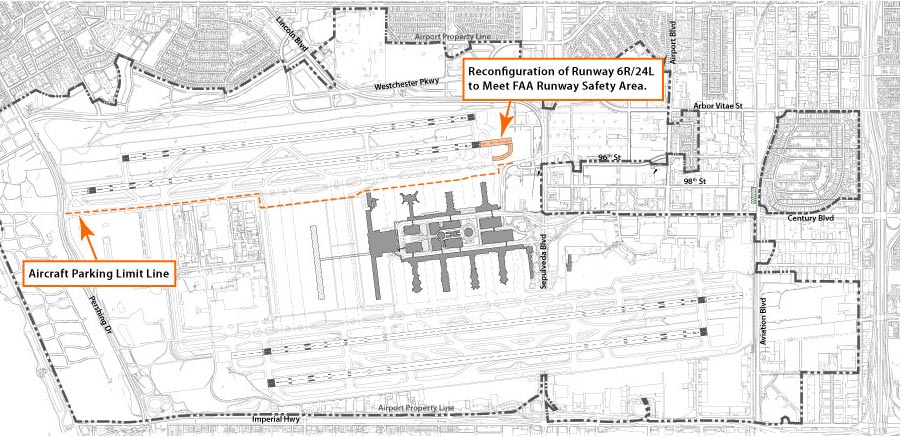
Terminals Current Issues
- Larger aicraft wingspans require greater distances between aircraft gates than available today.
- Some North Airfield improvement options, including the LAX Master Plan move of Runway 6R-24L, would move taxiways too close to Terminals 1, 2, and 3.
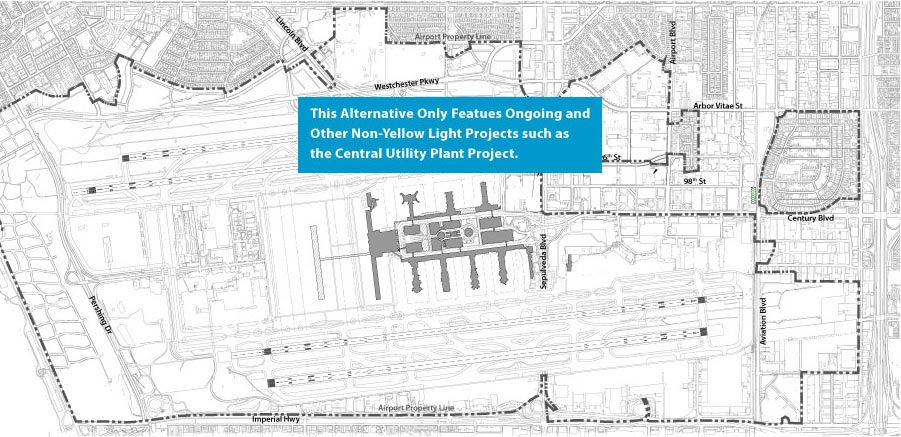
Ground Transportaion Current Issues
- Central Terminal Area (CTA) roadway system design currently creates queuing, weaving, and conflicts at various locations that impede traffic flow.
- During peak travel times, inbound airport traffic currently extends out of the Central Terminal Area (CTA) roadways onto public streets and may worsen as airport activity returns and grows.
- Curbside demand is unevenly distributed, especially during peak periods, creating concentrations of passengers that are not accommodated by the existing curbside system.
- As cumulative regional traffic increases, there will be less time certainty for airport users without easy access to the airport from the regional transit system.
- The roadway system is not designed to efficiently accommodate security screening of vehicles entering the CTA.
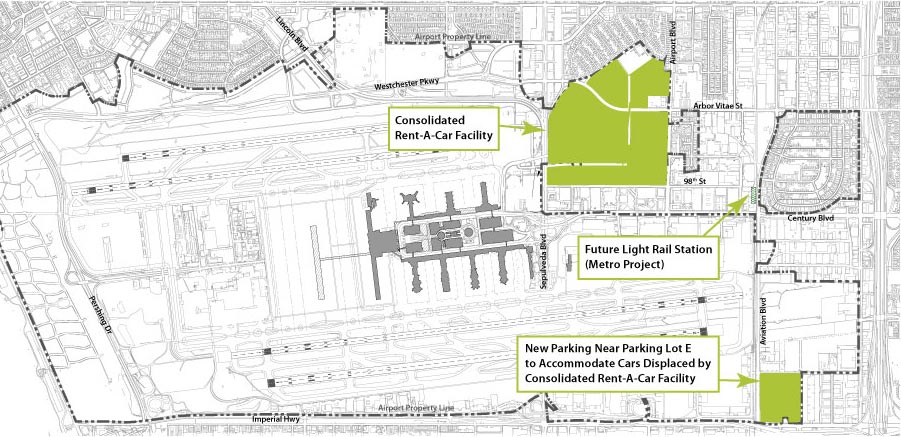
North Airfield Current Issues
- LAX does not meet federal standards for the largest aircraft now in service (Group 5 and 6 aircraft).
- Current North Airfield configuration requires the use of non-standard operating procedures, which are not optimal for safety and increase aircraft delay.
- Outdated airfield design creates a situation where aircraft are at an increase risk of hazards, including incursions and conflicts with other aircraft and vehicles.
- North Airfield runways are too short for most larger aircraft used for long-haul flights, requiring extra taxiing to the South Airfield.
- Existing North Airfield Runway Protection Zone (RPZ) overlays residential areas.
- Insufficient areas at the ends of the North Airfield runways for holding arriving flights and sequencing departures.
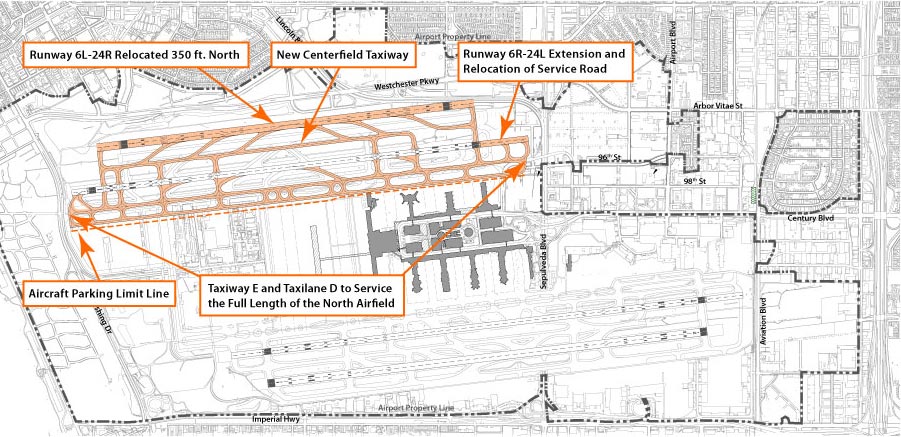
Terminals Current Issues
- Larger aicraft wingspans require greater distances between aircraft gates than available today.
- Some North Airfield improvement options, including the LAX Master Plan move of Runway 6R-24L, would move taxiways too close to Terminals 1, 2, and 3.
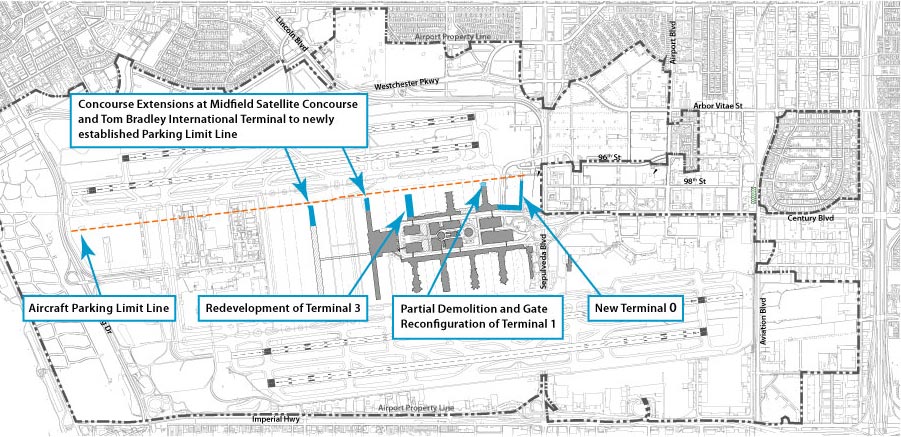
Ground Transportaion Current Issues
- Central Terminal Area (CTA) roadway system design currently creates queuing, weaving, and conflicts at various locations that impede traffic flow.
- During peak travel times, inbound airport traffic currently extends out of the Central Terminal Area (CTA) roadways onto public streets and may worsen as airport activity returns and grows.
- Curbside demand is unevenly distributed, especially during peak periods, creating concentrations of passengers that are not accommodated by the existing curbside system.
- As cumulative regional traffic increases, there will be less time certainty for airport users without easy access to the airport from the regional transit system.
- The roadway system is not designed to efficiently accommodate security screening of vehicles entering the CTA.

North Airfield Current Issues
- LAX does not meet federal standards for the largest aircraft now in service (Group 5 and 6 aircraft).
- Current North Airfield configuration requires the use of non-standard operating procedures, which are not optimal for safety and increase aircraft delay.
- Outdated airfield design creates a situation where aircraft are at an increase risk of hazards, including incursions and conflicts with other aircraft and vehicles.
- North Airfield runways are too short for most larger aircraft used for long-haul flights, requiring extra taxiing to the South Airfield.
- Existing North Airfield Runway Protection Zone (RPZ) overlays residential areas.
- Insufficient areas at the ends of the North Airfield runways for holding arriving flights and sequencing departures.
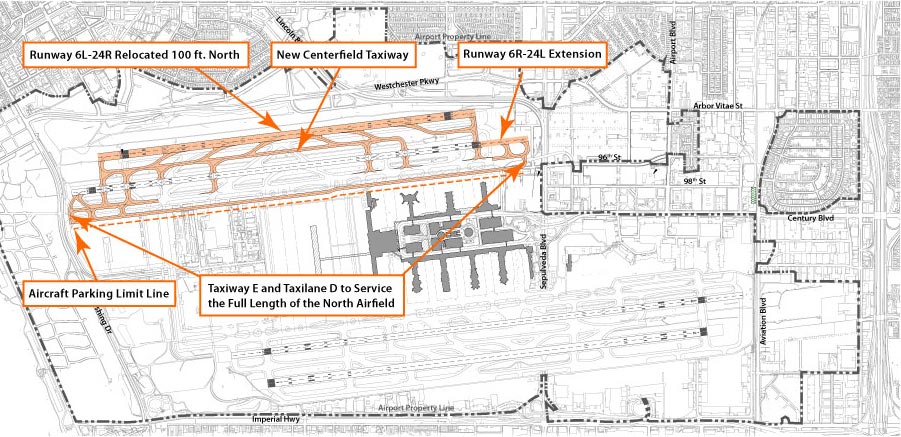
Terminals Current Issues
- Larger aicraft wingspans require greater distances between aircraft gates than available today.
- Some North Airfield improvement options, including the LAX Master Plan move of Runway 6R-24L, would move taxiways too close to Terminals 1, 2, and 3.
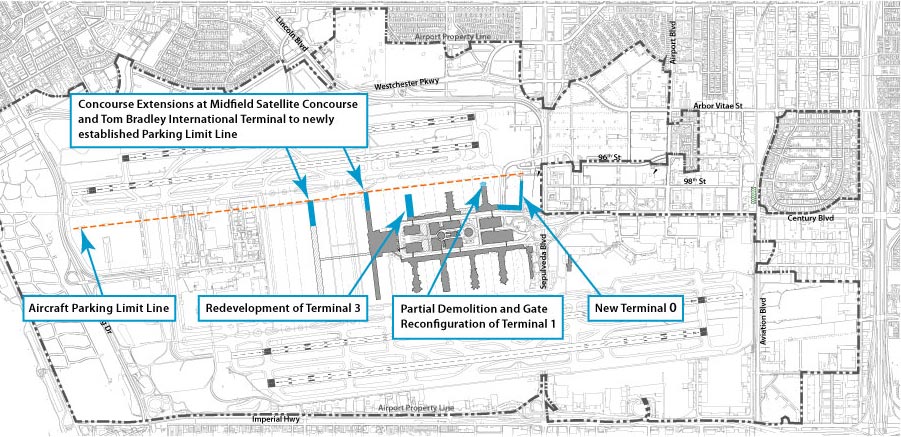
Ground Transportaion Current Issues
- Central Terminal Area (CTA) roadway system design currently creates queuing, weaving, and conflicts at various locations that impede traffic flow.
- During peak travel times, inbound airport traffic currently extends out of the Central Terminal Area (CTA) roadways onto public streets and may worsen as airport activity returns and grows.
- Curbside demand is unevenly distributed, especially during peak periods, creating concentrations of passengers that are not accommodated by the existing curbside system.
- As cumulative regional traffic increases, there will be less time certainty for airport users without easy access to the airport from the regional transit system.
- The roadway system is not designed to efficiently accommodate security screening of vehicles entering the CTA.
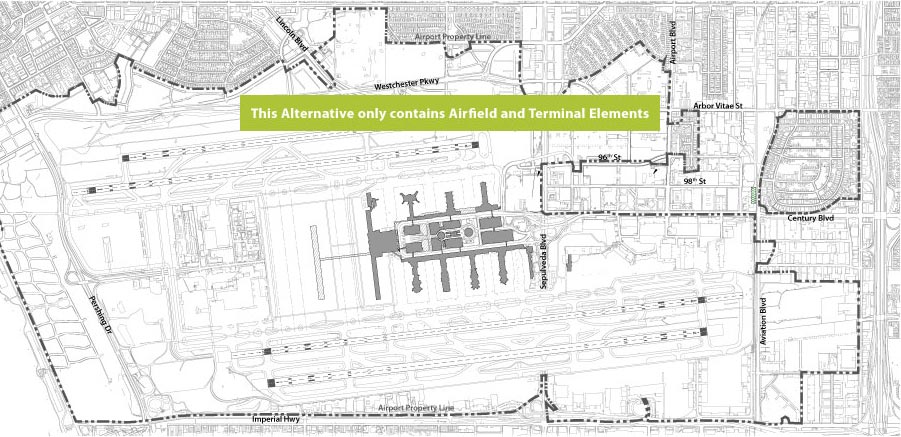
North Airfield Current Issues
- LAX does not meet federal standards for the largest aircraft now in service (Group 5 and 6 aircraft).
- Current North Airfield configuration requires the use of non-standard operating procedures, which are not optimal for safety and increase aircraft delay.
- Outdated airfield design creates a situation where aircraft are at an increase risk of hazards, including incursions and conflicts with other aircraft and vehicles.
- North Airfield runways are too short for most larger aircraft used for long-haul flights, requiring extra taxiing to the South Airfield.
- Existing North Airfield Runway Protection Zone (RPZ) overlays residential areas.
- Insufficient areas at the ends of the North Airfield runways for holding arriving flights and sequencing departures.
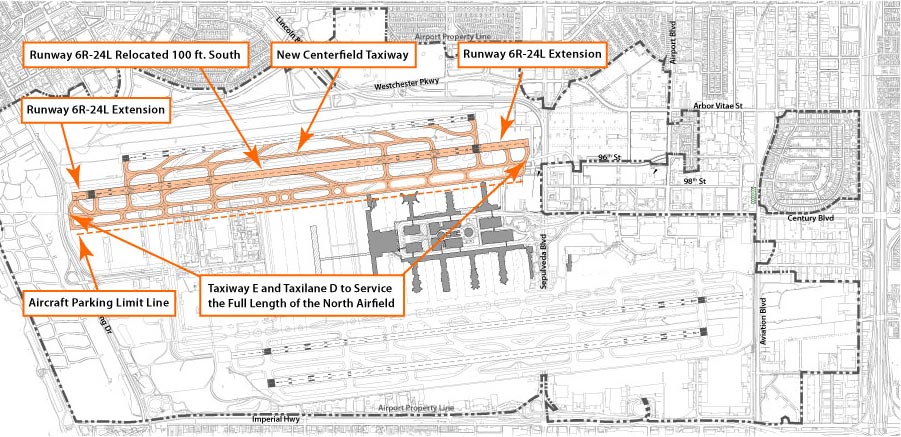
Terminals Current Issues
- Larger aicraft wingspans require greater distances between aircraft gates than available today.
- Some North Airfield improvement options, including the LAX Master Plan move of Runway 6R-24L, would move taxiways too close to Terminals 1, 2, and 3.

Ground Transportaion Current Issues
- Central Terminal Area (CTA) roadway system design currently creates queuing, weaving, and conflicts at various locations that impede traffic flow.
- During peak travel times, inbound airport traffic currently extends out of the Central Terminal Area (CTA) roadways onto public streets and may worsen as airport activity returns and grows.
- Curbside demand is unevenly distributed, especially during peak periods, creating concentrations of passengers that are not accommodated by the existing curbside system.
- As cumulative regional traffic increases, there will be less time certainty for airport users without easy access to the airport from the regional transit system.
- The roadway system is not designed to efficiently accommodate security screening of vehicles entering the CTA.
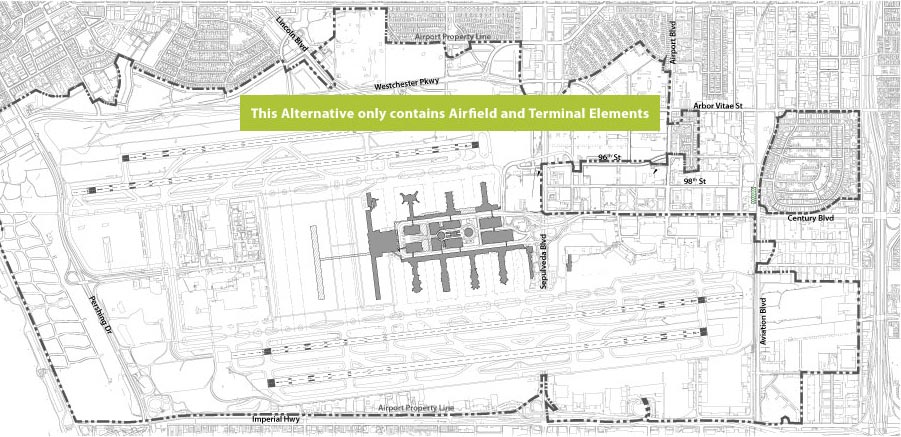
North Airfield Current Issues
- LAX does not meet federal standards for the largest aircraft now in service (Group 5 and 6 aircraft).
- Current North Airfield configuration requires the use of non-standard operating procedures, which are not optimal for safety and increase aircraft delay.
- Outdated airfield design creates a situation where aircraft are at an increase risk of hazards, including incursions and conflicts with other aircraft and vehicles.
- North Airfield runways are too short for most larger aircraft used for long-haul flights, requiring extra taxiing to the South Airfield.
- Existing North Airfield Runway Protection Zone (RPZ) overlays residential areas.
- Insufficient areas at the ends of the North Airfield runways for holding arriving flights and sequencing departures.
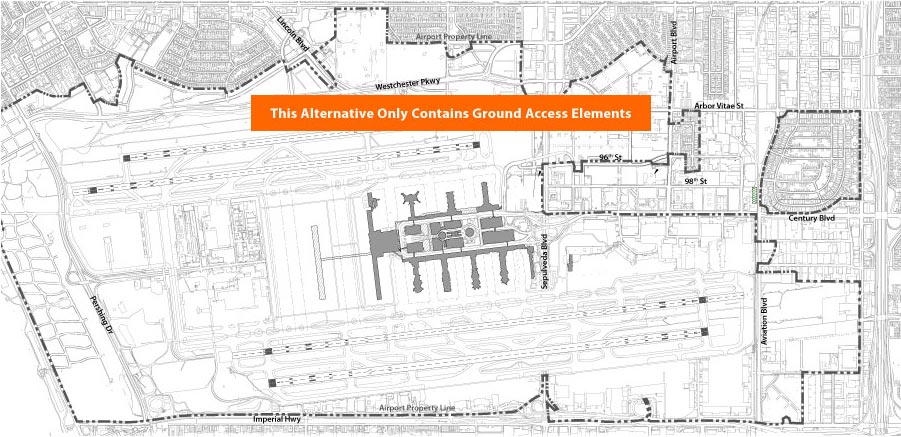
Terminals Current Issues
- Larger aicraft wingspans require greater distances between aircraft gates than available today.
- Some North Airfield improvement options, including the LAX Master Plan move of Runway 6R-24L, would move taxiways too close to Terminals 1, 2, and 3.
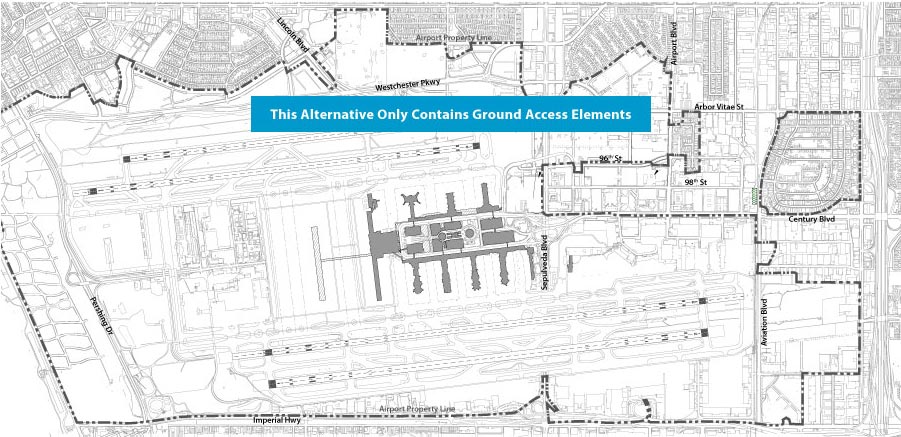
Ground Transportaion Current Issues
- Central Terminal Area (CTA) roadway system design currently creates queuing, weaving, and conflicts at various locations that impede traffic flow.
- During peak travel times, inbound airport traffic currently extends out of the Central Terminal Area (CTA) roadways onto public streets and may worsen as airport activity returns and grows.
- Curbside demand is unevenly distributed, especially during peak periods, creating concentrations of passengers that are not accommodated by the existing curbside system.
- As cumulative regional traffic increases, there will be less time certainty for airport users without easy access to the airport from the regional transit system.
- The roadway system is not designed to efficiently accommodate security screening of vehicles entering the CTA.
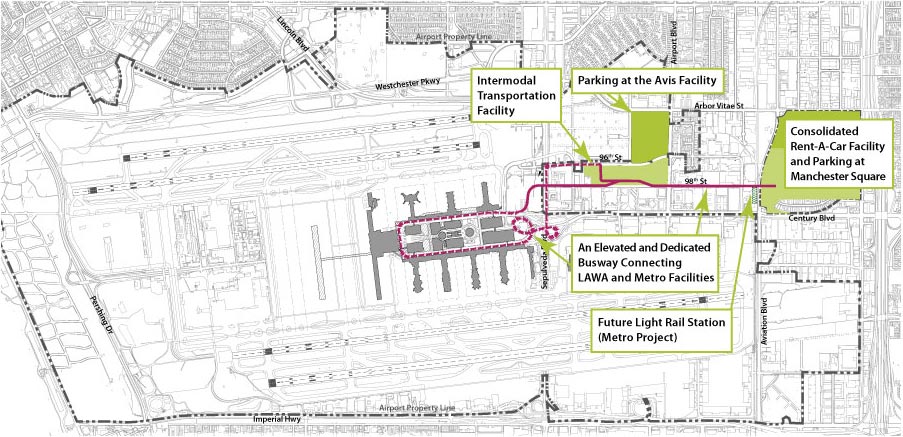
North Airfield Current Issues
- LAX does not meet federal standards for the largest aircraft now in service (Group 5 and 6 aircraft).
- Current North Airfield configuration requires the use of non-standard operating procedures, which are not optimal for safety and increase aircraft delay.
- Outdated airfield design creates a situation where aircraft are at an increase risk of hazards, including incursions and conflicts with other aircraft and vehicles.
- North Airfield runways are too short for most larger aircraft used for long-haul flights, requiring extra taxiing to the South Airfield.
- Existing North Airfield Runway Protection Zone (RPZ) overlays residential areas.
- Insufficient areas at the ends of the North Airfield runways for holding arriving flights and sequencing departures.

Terminals Current Issues
- Larger aicraft wingspans require greater distances between aircraft gates than available today.
- Some North Airfield improvement options, including the LAX Master Plan move of Runway 6R-24L, would move taxiways too close to Terminals 1, 2, and 3.
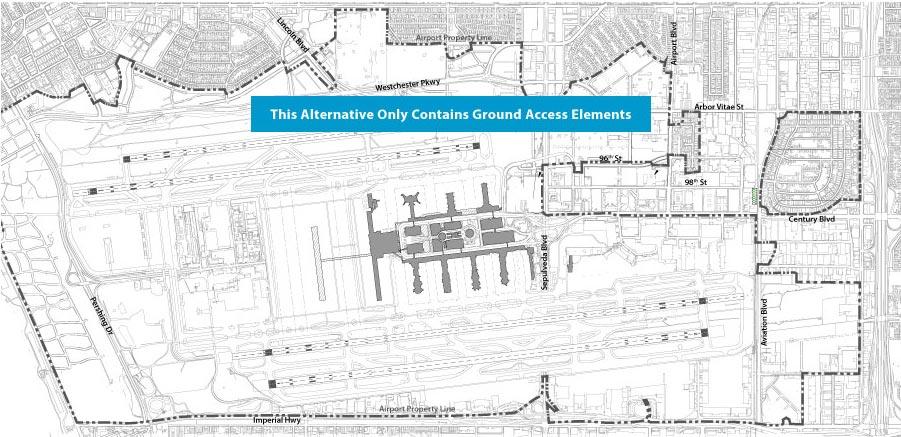
Ground Transportaion Current Issues
- Central Terminal Area (CTA) roadway system design currently creates queuing, weaving, and conflicts at various locations that impede traffic flow.
- During peak travel times, inbound airport traffic currently extends out of the Central Terminal Area (CTA) roadways onto public streets and may worsen as airport activity returns and grows.
- Curbside demand is unevenly distributed, especially during peak periods, creating concentrations of passengers that are not accommodated by the existing curbside system.
- As cumulative regional traffic increases, there will be less time certainty for airport users without easy access to the airport from the regional transit system.
- The roadway system is not designed to efficiently accommodate security screening of vehicles entering the CTA.
